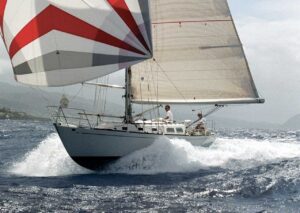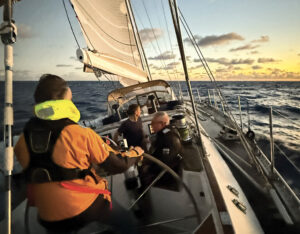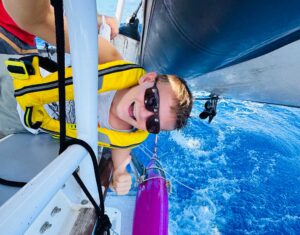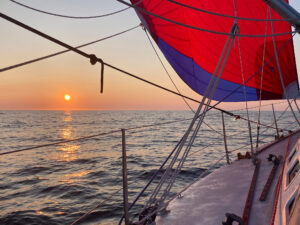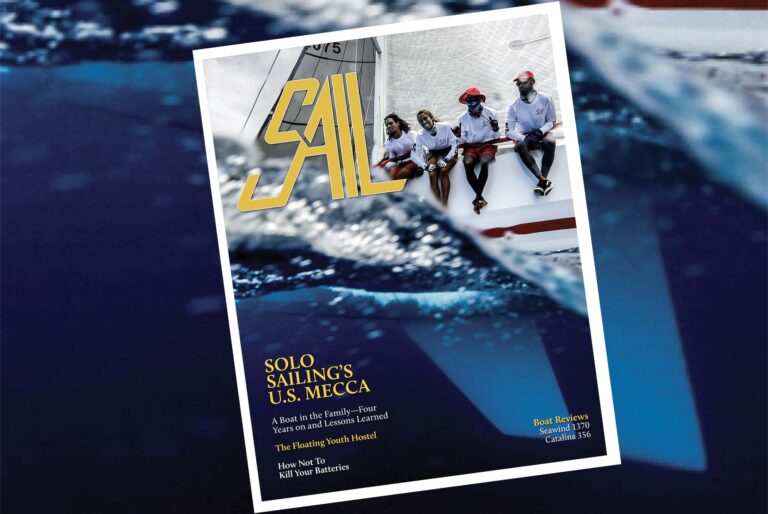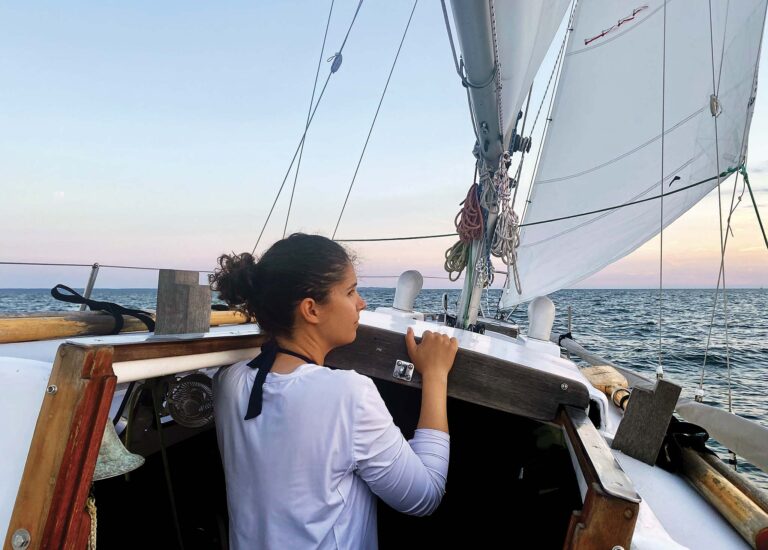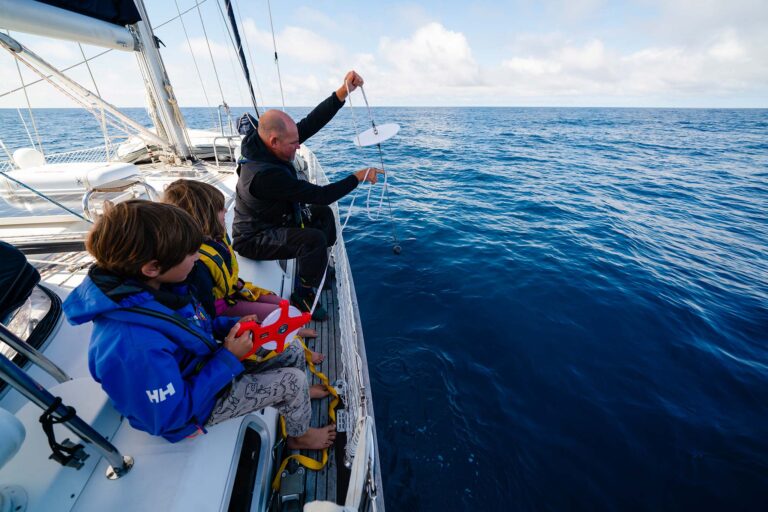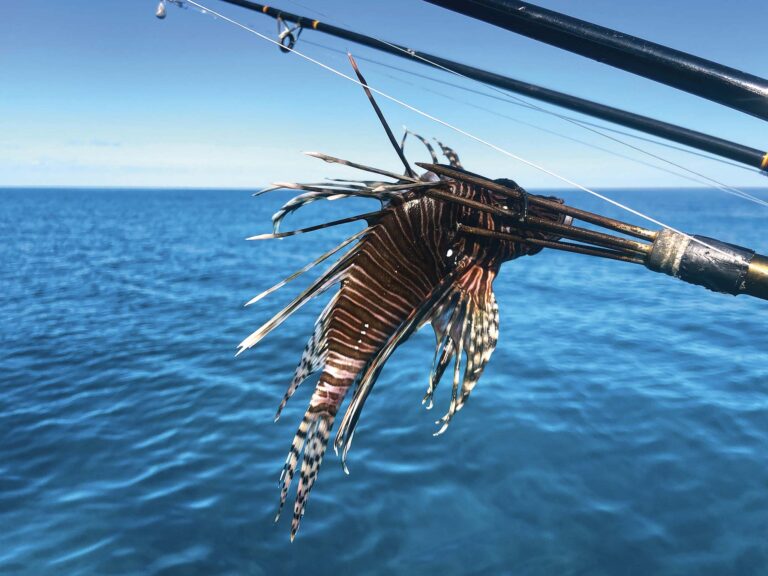Yes, temperatures may be high, but there are brisk southeasterlies, warm waters, and the bimini
Evening was still very hot. Friends had told us not to miss the unique monastery on Cat Island, and my wife, Carol, seemed eager and able. But as we traipsed the beachfront in the sun, I was waiting for my life to flash before my eyes. Going out in the noonday sun has never seemed wise, and going out at 1800 was not looking a lot better. Sun-blocked and water-bottled, trekking toward the top, no sea breeze, no sundowner, one Topsider after the other, I wondered not only if I was going to make it, but if we hadn’t made a huge mistake by cruising the Bahamas in summer.
Where was this site, this secret treasure? Why had fellow cruisers been so enthusiastic? Father Jerome came to Cat Island (elevation 206 feet, highest in the Bahamas) to build his “gift to God” before World War II. He had no helpers. All on his own he hewed, carried, and fitted stones atop the saddle of Mt. Alvernia. At last I saw it, blue and white like a postcard from Mykonos, off in the distance—way off in the distance. Imposing, graceful, and austere as it first appeared, however, there was a secret. Father Jerome built only a tiny, quarter-scale replica of a medieval monastery. Instead of having to climb for miles, we were there in a (relative) heartbeat.
As we pushed north through the Bahamas in Arête, our well-worn CS 36, I began to see the mini-monastery as a metaphor: the worries and problems we’d anticipated turned out to be much smaller in reality. Like the all-round view from Cat’s summit, the pleasures and paybacks were more than worth the trip.
Hurricanes are a big worry. They keep many cruisers away from the Bahamas once the “official” season starts in June. Will and Erika, our son and daughter-in-law, left Arête in George Town, the capital of the Exumas and the southernmost Bahamas cruising center, after six months of sun-seeking. They stayed aboard through the famous Family Island Regatta and then, toward the end of May, buttoned her up in Stocking Island, one of the Caribbean’s best hurricane holes. Lil Toot, her guardian, and the surrounding hills provided superb security; the boat was fine when we arrived in July. What to do if/when a tropical depression materialized during our cruise, however, remained an open question.
Luck was with us. Our biggest scare came from Tropical Storm Chris, a fizzler that missed by a lot. (On our way up the ICW, however, Hurricane Ernesto caught us in North Carolina). Cruising guides, from the traditional Yachtsmans Guide to the Bahamas to the chatty Skipper Bob, all identify and compare possible storm refuges. I liked the information and advice from Steven Pavlidis’s guides the best, but I found that even he excluded some possibilities (like Pirate’s Lair on Warderick Wells) that looked great to me. Keeping a weather eye out for the nearest place to hole up became a theme of our cruise. A friend who’s ridden out two Caribbean killers advised, “Button up the boat, then get the hell out of there.” The risk of hurricanes is real, but I’m glad it didn’t keep us from six weeks of the best cruising we’ve ever had.
“Isn’t it hot in the summertime?” we asked before we went. Yes, temperatures in the 90s aren’t unusual. But then neither is a 15-to-18-knot southeaster. We heard satellite-radio news reports of brownouts, emergency conditions, and general hysteria on the mainland in the summer of ’06. Sitting beneath the bimini in the breeze, we couldn’t help but smile.
Provisioning in the Bahamas isn’t idyllic. Local fare is limited and often picked over. Centers like New Providence, George Town, and Marsh Harbour have supermarkets, but on most smaller islands the “convenient stores” stock only what’s convenient. Marinas, especially in the Out Islands, take great glee in keeping the pirate tradition alive. (They were asking 50 cents a gallon for water at Highborne Cay.) However, before crossing the Gulf Stream, Will and Erika had haunted stateside outlets (Piggly-Wiggly, WalMart, et al), and forethought and creative stowage had made Arête somewhat self-sustaining.
From George Town we sailed east, just over 40 miles, to Long Island. Columbus wrote about anchoring there. We dropped our hook near the south end of Hog Island Cay. A nearby airstrip seemed dedicated to the only house in sight, an impressive (but not lavish) three-story. No one was home; we shared the solitary spot with a flock of West Indian whistling geese. The wave lap, the wind, and the weird calls of the geese made us realize we weren’t in Long Island Sound.
A beam reach in Force 6–7 brought us quickly to Cat Island, which seemed simpler and slower than the Exumas. We were picked up and taken shopping by a local schoolteacher driving home with her son. Later we bought ice from the freezer in her friend’s home.
Navigation among the islands used to be a challenge. Open stretches, uncharted coral heads, confusing landmarks, and unreliable nav aids are still concerns, but our GPS took most white-knuckling away. Often surrounded by cigarette boats and center-consoles at the fuel docks, we came to wax nostalgic for the good old days when getting from place to place made people think twice about exploring the Bahamas. We experimented at times with upstream/downstream anchoring and had to dive occasionally to set a stubborn hook, but overnighting was simpler than we’d feared. And many of those anchorages earned high marks on our all-time list.
After our 55-mile passage from Cat Island, for instance, we reentered the Exumas at Black Point. Exquisite holding and shelter made it a fine landfall, but after we’d had chicken dinner with conch fritters at Lorraine’s emphatically family-style restaurant and toured Willy’s unique menagerie of driftwood statuary (“I see de shapes in de clouds and den I look for dem on de beach”), it became a prominent page in our memory book.
In our five years of Mediterranean cruising we could number solitary anchorages on the fingers of one hand. By the time we were halfway up the Exumas, we had to start using our toes. Pirate’s Lair on Warderick Wells has park-maintained moorings. Even though we shared the place with a cruising megayacht, it didn’t spoil our image of the 16th- and 17th-century buccaneers who hid their ships there and caroused ashore in the still-extant clearing around the well. Shroud Cay, to the north, offered a tricky entrance, a hurricane-hole creek mouth, and a 2-mile African Queen journey through the mangroves to a skinny-dippable beach on the ocean side. Norman’s, made infamous by drug busts and murder in the ’80s, was eerily deserted (as were the sunken remains of a crashed twin-engine drug-smuggling plane on the flats to the south).
The opposite was true at Staniel, (where a fishing tournament was in progress), Thunderball (where we had to wait in line to snorkel into the James Bond grotto), and nearby Big Major, where the attraction is the pigs. Living wild in the brush, they attract boatloads of swine-feeders. We had the animals to ourselves at 0800, but by 1000 they had been stuffed to the point of preferring sunbathing to more gorging. We saw 34 boats in the roadstead, 29 of which were chartered or private megayachts. Not included in the jet skiing, waterskiing, and general conviviality of the anchorage, we left.
We saw two iguanas (also cruiser-maintained) on Farmer’s Cay, but when we holed up in the cul-de-sac anchorage at the top of Southwest Allans Cay, we dinghied ashore to play with a baker’s dozen. Will caught barracuda; we didn’t. We saw turtles and rays. We ate fresh conch wherever and whenever. Much of the spice of our out-island cruising came from solitude, beaches, and wildlife. We weren’t looking forward to trading it all for citified Nassau, but we had agreed to pick up friends there, and we needed to have some welding done. Eyeball piloting, never an exact science, was impossible on the cloudy Yellow Banks as we made our passage from Allans, but the gods and the GPS delivered us to an anchorage west of Yacht Haven. Squalls and heat made our stay less than idyllic, but getaways to Bottom Harbour on Rose Island sustained us, and within the week we were back to sea.
We reefed and unreefed the main four times on the 30-mile beat to Eleuthera (not to mention rolling the jib through most of its sizes.) We weren’t just being finicky. What started out as a 25-knot southeaster went through enough ups and downs to make the effort necessary. Throughout the summer there was almost always breeze and usually plenty of water. The places made the summer, but being able to sail so often put the icing on the rum cake.
Royal Island, like the sunken plane off Norman’s or the cabbage-palm circle surrounding the pirates’ watering hole, was evocative. Overlooking a broad bay (entered through a “clashing rocks” opening not three times wider than Arête) stood the better part of a jungle-claimed mansion. Terraced gardens and curved stairways led up to a deserted, eyeless brownstone. The guidebooks were sketchy, and we wondered who’d built it and why they’d left. When Bandit, a fisherman who moonlights as the president of the Eleuthera Historical Society, piloted us through the Devil’s Backbone to Harbor Island, we got the whole story. The owner/builder of the mansion, an American of great wealth, lived there and commuted worldwide via seaplane. At one point his wife arrived to find both him and his mistress. “I’m not leaving the island until you give me my share and a divorce,” she is reputed to have said. “Of course, she never left the island,” Bandit concluded. “I know. My aunt was a chambermaid, and I played at the estate when I was young.”
Even more eye-opening was the cave where the Eleutheran Adventurers, the first European settlers of the island, lived in 1648. “They came from Bermuda, you know,” Bandit related. “There had been a slave revolt. Some of them were freed black men. They gave the island its name. It means ‘freedom’ in Greek.” We counted the $75 spent for a hazard-free two-hour passage past the “backbone” well spent.
Our friends flew home from Harbor Island; we crossed over to the Abacos. Revisiting the famous red-striped Hope Town light was a necessity, but we were pleased to discover interesting spots (like Pete’s Pub and Art Gallery, where we narrowly missed the Naked Dinghy Race), go sailing ( gybe for gybe up the channel to Marsh Harbour), and experience galas (like the pig roast at Nipper’s on Guana Cay) that more than filled our last days in the islands.
Before we left, we came across a fisherman butchering a barrel-size turtle at the Marsh Harbour waterside. We learned turtle lore (they always return where they’re spawned) and assurance (only the loggerheads are endangered) and contracted to return for steaks in the morning. That night a catamaran moored quayside caught fire and burned to the waterline. When we got the steaks, we got the story. It was the turtle man’s dock where the boat burned, and aside from being a bit red-eyed and sympathetic (the absentee owner was a liveaboard, undergoing surgery in Miami), he was matter-of-fact: “Lots of things happen in the islands.”
After digesting delectable steaks (“cook them like veal in a little wine”), we pointed north across the banks for Florida. You never know if or when you’ll get back, but if we don’t, it certainly won’t be because the Bahamas have nothing left to offer. Even in the summer.
Racer, cruiser, and teacher, Robby Robinson has spent a lifetime sailing and writing about it.

